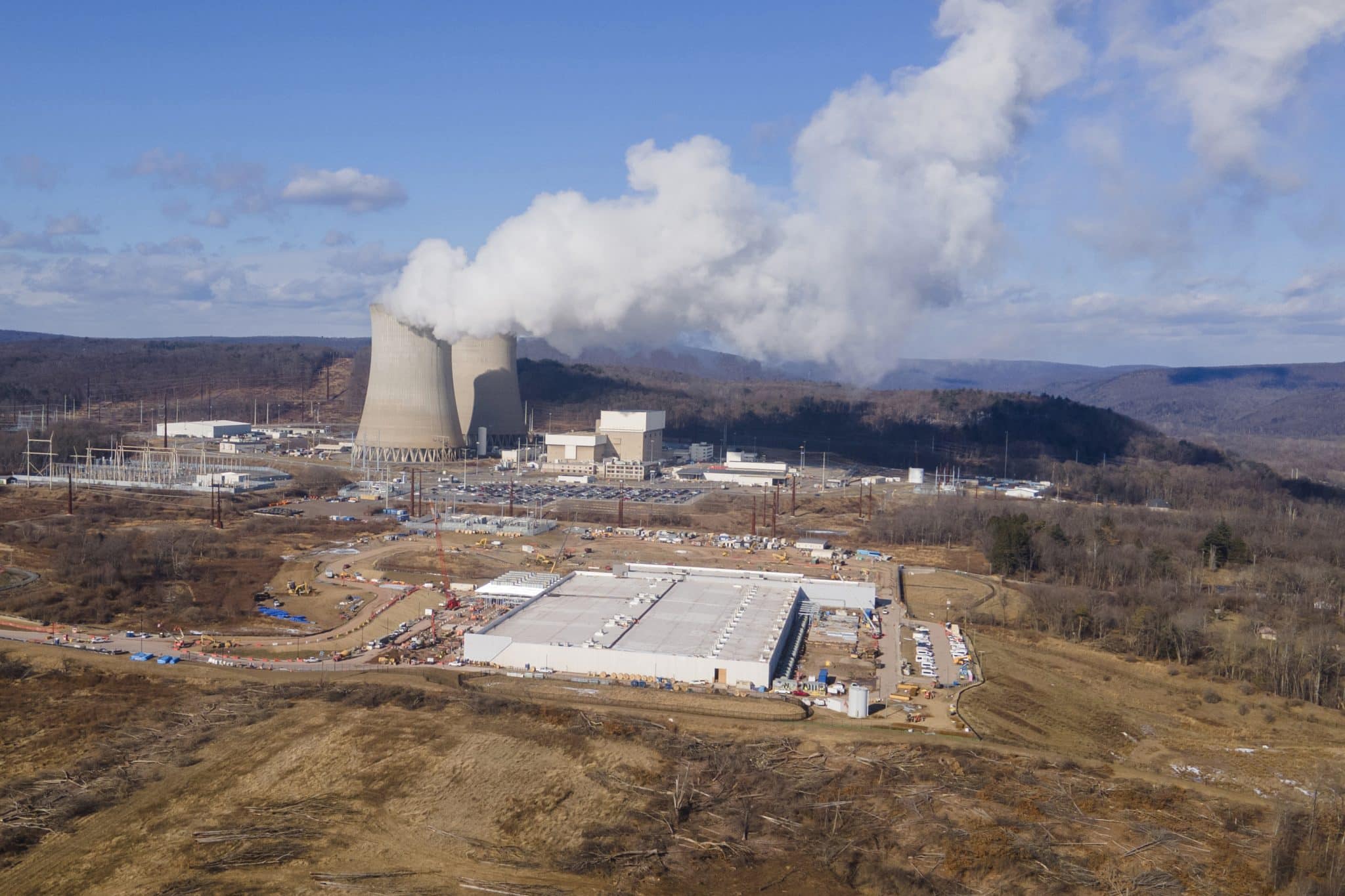This article originally appeared on Inside Climate News, a nonprofit, non-partisan news organization that covers climate, energy and the environment. Sign up for their newsletter here.
When Pennsylvania state Sen. Katie Muth toured a small data center in her suburban Philadelphia district this May, she was mostly impressed by what she found. It was quiet and impeccably clean—a largely unintrusive presence even in a wealthy enclave where some of the closest neighbors live in million-dollar homes. But in one corner of the facility, Muth found the source of growing concern in the state.
“The engineer that worked there showed us this cabinet farm that was kind of lightly shaking. It was very warm,” Muth said. “And he said it was an AI cabinet farm and that at certain times of the day, this sucker is just revving up.”
The copious amounts of power such AI servers require are already driving up energy bills for consumers in the state. Since her visit, Muth has announced plans to introduce the “Pennsylvania Ratepayer Protection Act,” just one of at least a dozen proposed or planned bills in Pennsylvania’s legislature addressing the hottest industrial issue in the commonwealth.
Some of the bills aim to further ramp up data center development by modifying permitting and zoning procedures. Other legislation, including a package of bills under the banner of Democratic Gov. Josh Shapiro’s “Lightning Plan,” seeks to combine permitting reform with policies focused on clean energy and consumer costs.
Whether any of them will find their way through the morass of Pennsylvania’s divided government remains to be seen.
Proponents of AI development view the technology’s arrival as the dawn of a new industrial era in this resource-rich state, following booms of iron, coal, natural gas and, more recently, e-commerce warehouses. Speaking at a Pennsylvania Senate hearing in August, Merle Madrid, senior manager of public policy for Amazon Web Services, said his company’s $20 billion investment in the state would create at least 1,250 new “high-skilled” jobs, support thousands of others and provide other benefits to host communities.
“Our investment in the commonwealth isn’t just financial, it’s also in the people and future of Pennsylvania,” Madrid said.
Others—such as John Quigley, a former secretary of the state’s Department of Environmental Protection and now senior fellow at the Kleinman Center for Energy Policy at the University of Pennsylvania—view likening AI to major industries of the past as a cautionary tale. The state has a long legacy of unresolved industrial pollution, and some of the economic promises have fallen short.
“Pennsylvania’s history is, we roll out the red carpet for every industry, regardless of whether its impacts are known or unknown,” Quigley said. “Then we find out later we made a mistake. … I don’t see too much indication we’re not on the same track.”
Muth is most interested in addressing the state’s swiftly rising energy costs, a dynamic playing out across a 13-state territory overseen by electric grid operator PJM Interconnection. Stretching from Chicago to New Jersey to eastern North Carolina, it’s the nation’s largest grid and includes all of Virginia and Pennsylvania, which consulting firm Wood Mackenzie ranks second and third among all states for announced data center development.
On June 1, many Pennsylvanians saw their electricity rates increase between 5 and 12 percent—and some as much as 40 percent—according to the Pennsylvania Public Utility Commission. And more is on the way. Each year, PJM holds “capacity auctions” for energy generation, which influence consumer costs by effectively balancing electricity supply against projected demand. Quigley notes that this summer’s auction was a record-setting $16 billion, more than seven times the total from just two years ago.
PJM predicts the latest auction will cause energy bills to rise by another 1.5 to 5 percent next year. While the organization says costs are increasing for several reasons, including electrification and regular economic growth, its independent market monitor cites data centers as the primary and “unprecedented” cause, accounting for about $9.3 billion of this year’s prices.
Muth’s upcoming legislation is focused on yet another factor in costs: transmission. New industrial facilities that use copious amounts of electricity, like data centers, often require new power lines and other energy infrastructure to operate. In Pennsylvania, that’s the domain of transmission companies like PECO and PPL, which pass along the costs of building new distribution lines to customers.
Muth said her bill is modeled on existing policies in Oregon that require “high-load” customers to fully cover the costs of infrastructure created for their benefit.
“I think the general public, all party affiliations, don’t want to pay these increased utility bills. They can’t afford them,” Muth said. “I can remember my own grandmother saying, ‘I don’t want to turn on the air conditioner because I don’t want my electricity bill to go up.’ And I hate to think that people have to make those decisions and sit there and suffer.”
But garnering the support of her colleagues will likely prove difficult. The state’s politics are increasingly acrimonious: The Republican-controlled Senate and Democrat-occupied House and governor’s office have butted heads, most recently over a state budget that is now more than two months overdue. Some in the state capital of Harrisburg, such as Elizabeth Marx, executive director of the Pennsylvania Utility Law Project, doubt there’s much room for compromise.
“I do not see the Pennsylvania General Assembly breaking gridlock on any energy issues anytime soon,” Marx said. “While there are some common threads of agreement that we need to protect consumers from increased rates as a result of data centers, there is not agreement on the ‘how.’”
Still, others say AI-related legislation is important to track, as it shapes the policy landscape in which a future deal may be forged. And some kind of action may become unavoidable as consumer costs—and anger—rises, said Katie Blume, political and legislative director of the nonprofit advocacy group Conservation Voters of Pennsylvania.
“We need to socialize these ideas with the legislature, with the public, and we need to make sure that people are brought into conversations who are going to be impacted by these things,” Blume said. “And I think the Senate Republicans who always say, ‘We don’t want to do anything on energy right now,’ are going to be in between a rock and a hard place before too long.”
Power Plays
On the surface, there does appear to be at least some common ground among Pennsylvania lawmakers on AI data center development: getting more of it.
In Pittsburgh in early July, U.S. Senator Dave McCormick, a Pennsylvania Republican, convened an Energy and Innovation Summit that drew both President Donald Trump and Shapiro. All three expressed excitement over what McCormick says is more than $90 billion in investments announced by tech companies in the state.
The legislature has previously found its way to a deal in the space. In 2021, a tax bill that included a measure to strengthen an existing tax credit for purchasing servers and other equipment for large data centers in the state passed with wide bipartisan support. The incentive currently costs the state about $43 million in tax revenue a year, and Shapiro’s office projects it will eclipse $50 million annually by the end of the decade. But politicians, including Shapiro himself, have cited it as key to growing the industry in the state, with a spokesperson for the governor telling Spotlight PA that it will “generate hundreds of millions of dollars in new tax revenue for state and local governments.”
Shapiro’s Lightning Plan is a package of six bills that, altogether, seek to create a new “streamlined” permitting process for key energy projects, create new tax incentives for diverse energy sources, create a cap-and-trade program for carbon emissions, bolster renewable energy and attempt to address energy costs in rural and low-income communities. Although the package does not directly address the buildout of AI data centers, it focuses on spurring new energy generation needed by the power-hungry sector and is similar to some other bills specifically addressing AI.
Many of the Lightning Plan measures, such as the carbon program, are supported by Democratic rank-and-file members seeking effective climate policy. But those focused on permitting reform bear similarities to AI bills introduced by Republicans. Senate Bill 939, introduced by Republican state Sen. Greg Rothman with at least one Democratic co-sponsor, proposes creating a “Commonwealth Opportunity Zone” that would create a fast-track permitting process for data centers, as well as a “regulatory sandbox” encouraging deregulation.
“This innovative, collaborative framework will enable industry leaders to work directly with state agencies to identify and remove unnecessary and outdated regulations, thereby streamlining the development process and accelerating innovation,” Rothman’s office, which did not respond to inquiries from Inside Climate News, stated in a press release announcing the proposal.
A Republican colleague in the House, Rep. Jason Ortitay, introduced a bill to create a “Keystone Artificial Intelligence Authority” to similarly “streamline and coordinate” permitting through a new, centralized process. Other Republicans say they are preparing to introduce measures also designed to accelerate data-center permitting and create new tax incentives, with some bipartisan support.
Asked to comment for this story, Shapiro’s office touted a focus on permit reform, noting the governor already established an Office of Transformation and Opportunity “as a one-stop-shop for businesses looking to grow in the Commonwealth.” In 2024, his administration also launched the PA Permit Fast Track Program, which it calls an innovative permitting system to “expedite major economic development and infrastructure projects,” including a data center campus in Northeast Pennsylvania.
“Governor Shapiro is laser-focused on getting stuff done and taking real action to lower Pennsylvanians’ energy costs through his commonsense, all-of-the-above energy plan to build more power in the Commonwealth, create a more reliable, affordable energy grid, and position the Commonwealth to continue to be a national energy leader for decades to come,” his office said in a prepared statement.
Among the points of conflict: Several Harrisburg insiders say Shapiro and Republican Senate Majority Leader Joe Pittman are at loggerheads on energy policy over the Regional Greenhouse Gas Initiative (RGGI), a cap-and-trade program spanning 10 neighboring states. Shapiro’s predecessor, Democratic Gov. Tom Wolf, joined the program in 2022, but Pennsylvania’s participation is tied up in the commonwealth’s courts.
Shapiro’s administration has defended the initiative in court but has floated PACER—the bill in the Lightning Plan that would create a state-run “cap-and-invest” program—as a preferred alternative.
Pittman’s office did not respond to requests for comment. But the senator previously told Spotlight PA the pending RGGI case leaves his caucus “very limited” in considering energy-related legislation, a dynamic that others say remains the status quo.
A Call From Inside the House
Some of Shapiro’s policies also face opposition from members of his own party, particularly RESET, another Lightning Plan bill. The legislation’s primary sponsor, state Rep. Mandy Steele, says it would create a “central cohesive authority” to approve siting applications for large energy-generating facilities.
Muth said that opposition to the bill from some southeast Pennsylvania Democrats crystallized in June when the House Energy Committee held a hearing on the legislation. A bevy of environmental groups came out against it for fear the new state board could support new fossil fuel infrastructure while local officials objected to losing authority over siting.
The bill has the support of several Democratic committee members, labor organizations and environmental groups. The Natural Resources Defense Council and the Nature Conservancy think the board will boost clean energy buildouts.
Muth says she’s seen some potential Republican support percolating for the bill, which leads her to believe that deals could be coming, perhaps in next year’s budget negotiations, if not in the one still ongoing.
“My fear is we’re going to have this dumped into something,” Muth said. “It could happen tomorrow.”
Quigley, the energy expert and former DEP secretary, believes that if something does emerge from the legislature, it will likely focus primarily on deregulation and industry incentives, rather than consumer costs or environmental protection. Both the state’s powerful natural gas lobby and trade unions support AI development, he notes.
“There’s this rush to deregulate, to accommodate this industry that no one is prepared for,” Quigley said.
State Rep. Greg Vitali, another Southeast Pennsylvania Democrat and chair of the House Environmental & Natural Resource Protection Committee, is also concerned environmental considerations could be overlooked in the push for more AI and energy to feed it.
He notes that both the cap-and-trade bill PACER, as well as a PRESS bill that would require more renewables to be added to the state’s energy mix, have stalled even in the Democratically controlled chamber. The latter bill, he believes, has been held up after fossil fuel lobbyists convinced some House Democrats that a measure diminishing waste coal’s status in the energy mix would be harmful.
Vitali adds there’s also little to no activity in the House grappling with any climate or environmental harms directly generated by AI data center development. Natural gas may end up powering much of the nation’s data-center growth, and many of the tech promises to the contrary are short on details.
“When the governor announces his $20 billion deal with Amazon, you don’t hear any discussion of climate impacts. … It just seems to be one of the things people forget about,” Vitali said. “I think legislators are discouraged from talking about any issue in terms of climate because it’s almost become like a poison pill in anything you want to get through the Senate.”
Quigley says history has shown that “legislators always play catch-up” to new industries, and believes that will be the case with AI as well.
“These data centers can potentially use millions of gallons of water a day … and nobody’s raised the issue, nobody’s planned for it,” Quigley said, adding that millions of Pennsylvanians rely on groundwater wells for drinking water.
In an email, Amazon Web Services says its company is focused on efficiency and sustainability, with ongoing plans to reach net-zero carbon emissions by 2040 and be “water positive” by 2030, returning more water to communities than it uses.
“Amazon is continually improving water efficiency, using advanced cloud services, such as internet of things technologies, to analyze real time water use, identify and fix leaks, and gain other efficiencies,” the company said in its statement. “Amazon is further improving operational efficiency to reduce cooling water use in many facilities for most of the year, instead by relying on outside air.”
Mind Your Ps and Queues
In the absence of legislative action, policies set by the Pennsylvania Public Utility Commission and PJM could have an outsize effect.
The PUC is a quasi-independent state agency whose directors are appointed to terms by the governor. In April, the commission held a hearing about a potential “model tariff” on AI data center development, which Marx said could help ensure “large load” customers like data centers pay for any transmission costs they generate. The PUC could also facilitate rate assistance programs requiring companies to help low-income residents afford their energy bills, Marx said.
The release of a model tariff is expected soon: PUC spokesperson Dave Hixson told Inside Climate News that the commission is drafting a proposal with a goal to issue it “in the near future.”
READ: Here’s Why Pennsylvanians Are Seeing Their Electricity Bills Soar
Quigley adds that PJM is also taking steps to consider new policies, including measures that would require data centers to “bring their own power” to the grid instead of eating into existing capacity.
“So there’s two positive things,” Quigley said.
Jackson Morris, director of state power sector policy for the Natural Resources Defense Council, notes that, like the Pennsylvania legislature, PJM has also been subject to criticism over gridlock. Its new power generation queue remains backed up and renewable energy projects buried. He thinks something will have to give way to the pressures of the new AI paradigm.
“You’ve literally got governors running for office talking about PJM capacity, market reforms. Two, three years ago, you never heard a governor say the letters PJM,” Morris said. “We’re not living in that world anymore.”






